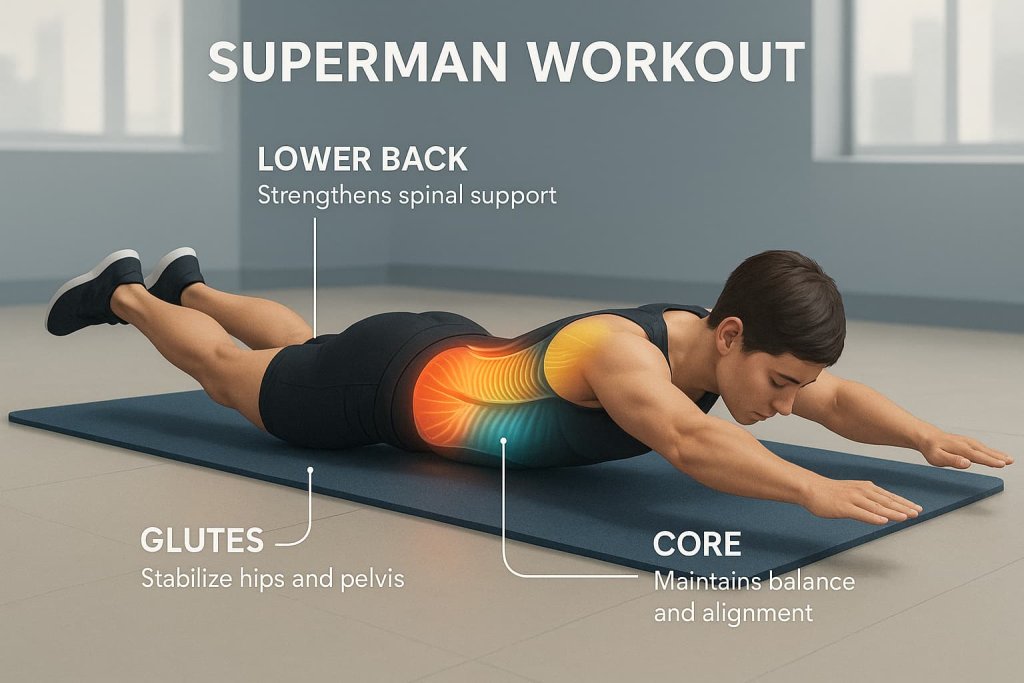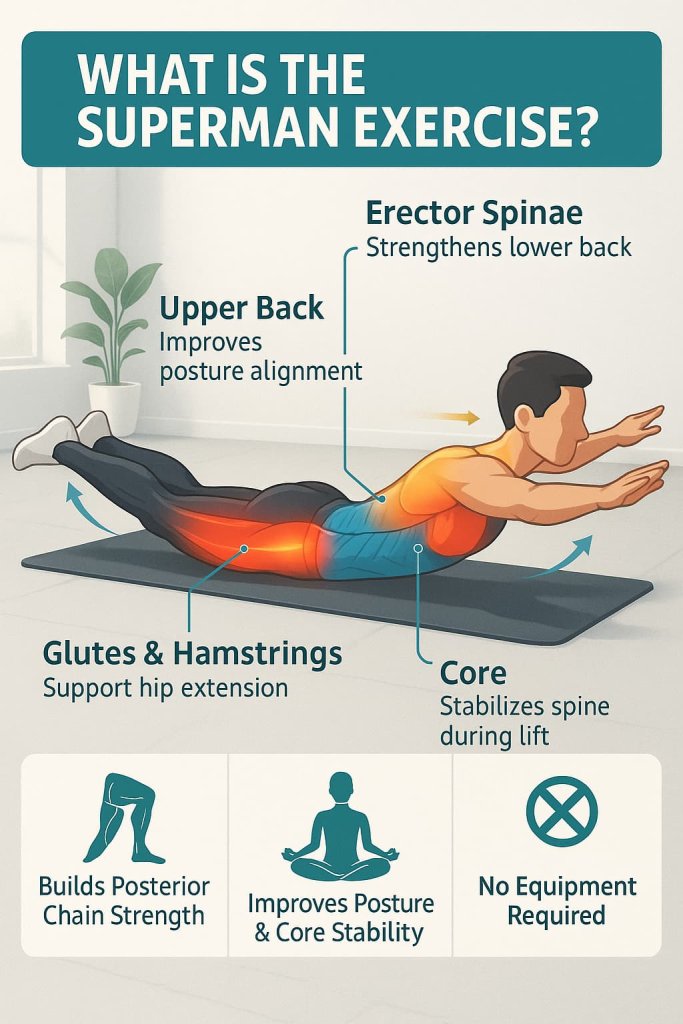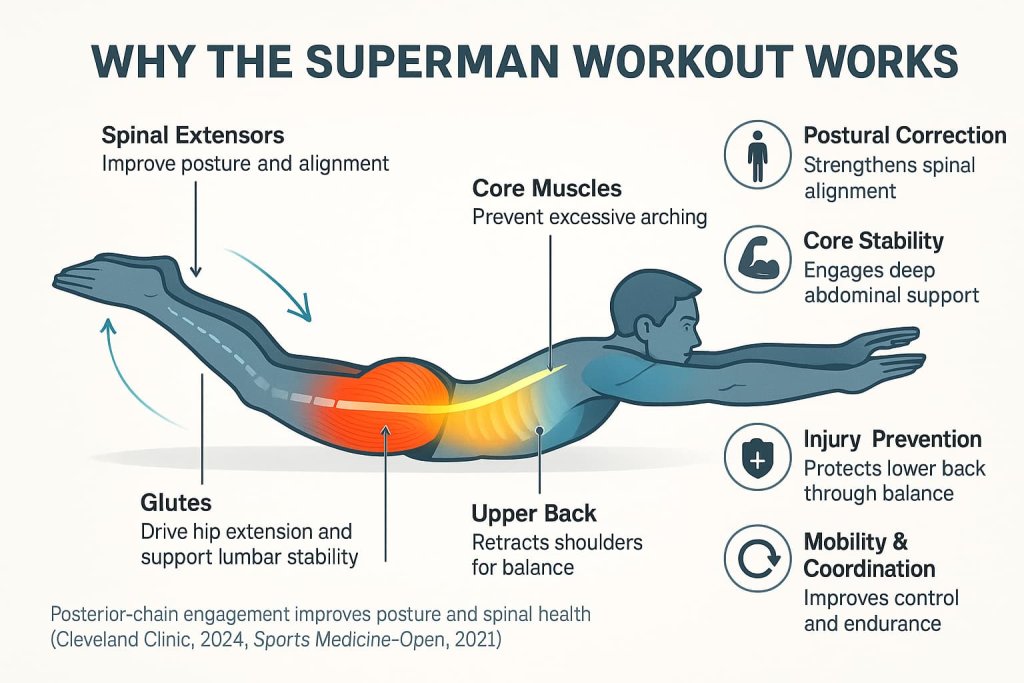The Superman workout is a simple yet powerful exercise that strengthens your back, core, and posture — no equipment required.
By mimicking Superman’s flying position, you activate the key stabilizing muscles of your lower back, glutes, and core, which help prevent pain and improve spinal alignment.

Understanding and practicing this movement regularly can support spinal health, reduce stiffness from sitting, and build the foundation for total-body strength. Whether you’re a beginner or athlete, the Superman workout trains your posterior chain — the powerhouse behind strong, functional movement.
For safe performance, always move with control and avoid excessive arching. Consult a healthcare professional if you have existing back issues.
What Is the Superman Exercise?
The Superman exercise involves lying face down and lifting your arms and legs simultaneously, mimicking a flying superhero.

This bodyweight move targets the erector spinae, glutes, hamstrings, and upper back muscles — crucial for posture and spinal support.
It’s one of the few no-equipment exercises that directly strengthens your spinal extensors and counteracts the effects of slouching and prolonged sitting.
Why the Superman Workout Works
The Superman exercise works by isometrically engaging your posterior chain, which includes the muscles responsible for extending your spine and hips.

Key Benefits
- Postural Correction: Strengthens the spinal extensors to pull your shoulders back and lengthen your spine.
- Core Stability: Engages deep abdominal muscles that stabilize your torso.
- Injury Prevention: Builds balanced strength to protect against lower-back strain.
- Mobility and Coordination: Improves control and awareness of your back-body muscles.
According to the Cleveland Clinic (2024), this movement helps develop endurance in your lower back muscles — a key factor in preventing chronic pain and improving posture for desk-bound individuals.
A 2021 review in the Journal of Strength and Conditioning Research also highlights that posterior-chain strengthening, including the Superman, significantly reduces spinal discomfort and enhances functional mobility.
How to Do the Superman Exercise
Step-by-Step Guide:
- Lie face down on a mat with arms extended overhead and legs straight.
- Engage your core and glutes.
- Simultaneously lift your arms, chest, and legs a few inches off the floor.
- Hold for 2–5 seconds while breathing steadily.
- Lower slowly and repeat for 10–15 reps.
Trainer Tip:
- Avoid hyperextending your back; focus on muscle contraction, not height.
- Keep your neck neutral by looking down at the mat.
- If it feels too intense, lift just your arms or legs until stronger.
Common Mistakes to Avoid
- Overarching the spine: Can cause lower-back strain.
- Jerky movements: Reduce control and increase risk of injury.
- Holding breath: Limits stability and muscle engagement.
- Fast repetitions: Lowering too quickly decreases effectiveness.
Always prioritize smooth, controlled motion to maximize benefits and safety.
Muscles Worked
Primary Muscles:
- Erector spinae (spinalis, longissimus, iliocostalis)
- Gluteus maximus
- Hamstrings
Secondary Muscles:
- Deltoids
- Trapezius
- Core stabilizers (multifidus, obliques, transverse abdominis)
These muscles work together to keep your spine extended, hips stable, and shoulders aligned.
Superman Workout Variations
1. Alternating Arm and Leg Raise
Why it works:
This variation reduces pressure on the lower back while still activating the erector spinae, glutes, and hamstrings. By alternating sides, it improves coordination, balance, and cross-body stability — crucial for athletic and everyday movements.
Muscles worked:
Erector spinae, gluteus maximus, hamstrings, deltoids, and core stabilizers (transverse abdominis, obliques).
How to do it:
- Lie face down with arms extended overhead.
- Lift your right arm and left leg off the floor simultaneously.
- Hold for 2–3 seconds, lower slowly, then switch sides.
- Repeat for 10–12 reps per side.
Trainer Tip:
Focus on slow, controlled lifts — imagine lengthening your body from fingertips to toes rather than lifting higher. Keep your hips grounded for maximum spinal alignment.
2. Superman Hold
Why it works:
Holding the Superman position builds isometric strength and endurance in your spinal extensors and glutes. This sustained tension helps improve posture and stability, particularly for those who sit for long hours.
Muscles worked:
Erector spinae, gluteus maximus, hamstrings, deltoids, and upper back (trapezius, rhomboids).
How to do it:
- Lie face down with arms extended.
- Engage your core and lift both arms and legs off the floor.
- Hold for 20–30 seconds, breathing steadily.
- Lower slowly and rest for 10 seconds between rounds.
Trainer Tip:
Start with shorter holds (10–15 seconds) and gradually increase duration. For comfort, place a folded towel under your hips or pelvis to reduce pressure.
3. Resistance Band Superman
Why it works:
Adding a resistance band increases tension during lifts, intensifying activation of your upper back, glutes, and shoulders. It’s a great way to build progressive strength without adding weights.
Muscles worked:
Erector spinae, glutes, deltoids, latissimus dorsi, and hamstrings.
How to do it:
- Wrap a light resistance band around your wrists or ankles.
- Lie face down with arms and legs extended.
- Lift arms and legs simultaneously while maintaining band tension.
- Hold briefly, then lower with control.
- Perform 8–12 reps.
Trainer Tip:
Use a moderate-tension band — too tight will strain your shoulders or hips. Focus on keeping the band taut throughout the lift for consistent resistance.
4. Swiss Ball Superman
Why it works:
Using a stability ball adds an element of balance, forcing your core and stabilizer muscles to work harder. It also reduces direct lower-back compression while improving proprioception.
Muscles worked:
Erector spinae, gluteus maximus, hamstrings, deltoids, trapezius, and core stabilizers.
How to do it:
- Position your abdomen on a Swiss ball, toes on the floor for balance.
- Extend your arms overhead and engage your core.
- Lift your arms and legs off the ball, forming a straight line from head to heels.
- Hold for 2–5 seconds, then return to start.
- Repeat for 10–15 reps.
Trainer Tip:
Keep movements small and controlled — don’t roll off the ball. The goal is balance and control, not height. For added challenge, bring feet closer together.
Safety & Precautions
Perform the Superman workout with control to avoid lower-back strain. Keep your lift small, core engaged, and movements smooth.
Avoid if you have:
- Herniated discs, sciatica, or chronic back pain
- Recent spinal injury or surgery
- Discomfort when lying face down
Use a padded mat, breathe steadily, and stop if you feel sharp pain. Beginners can modify with alternating arm and leg raises.
According to Duncan Sports Physical Therapy (2025), individuals with spinal disc issues, sciatica, or lumbar instability should approach this movement cautiously.
Modify by limiting range of motion or performing alternating lifts instead of full Superman extensions.
If you feel sharp pain or tingling, stop immediately and consult a qualified healthcare provider.
Integrating the Superman into Your Routine
- Add it to your core or back day workouts.
- Perform 2–3 sets of 12–15 reps, 3–4 times per week.
- Combine with planks, bird-dogs, and glute bridges for complete posterior-chain strength.
FAQ
1. Is the Superman exercise good for lower-back pain?
It may help strengthen the muscles that support the spine, but those with pain should consult a doctor before starting.
2. How long should I hold the Superman position?
Start with 2–3 seconds and build up to 10–15 seconds as endurance improves.
3. Can I do this every day?
Yes, if done gently and pain-free. For muscle growth, 3–4 times weekly is ideal.
4. What equipment do I need?
None — just a mat. You can add resistance bands for progression.
5. Is it safe for beginners?
Absolutely. Begin with small lifts and increase range as your back strengthens.
6. Can the Superman exercise replace back extensions?
It’s a great alternative, especially at home, but gym-based back extensions allow heavier resistance.
7. Does it help posture?
Yes — by strengthening spinal extensors and shoulder retractors, it improves upright alignment.
Conclusion
The Superman workout is a bodyweight powerhouse that enhances your posture, strengthens your core and back, and builds real-world functional stability.
Incorporate it consistently to protect your spine, counteract sitting-related weakness, and move with confidence — no cape required.
References
- Frontiers in Physiology (2024)
Motor Control + Isolated Lumbar Extension Improves Multifidus Properties — Supports spinal extensor/endurance rationale (YMYL evidence). - PubMed — Biering-Sørensen Test Reliability
Reliability and Validity of the Biering-Sørensen Test — Benchmarks lumbar extensor endurance relevant to isometric holds. - NICE Guideline — Low Back Pain & Sciatica (Over-16s)
Evidence-Based Guidance (NCBI Bookshelf) — When to modify exercises and seek care (YMYL safety). - Mayo Clinic — Core Strength Overview
Exercises to Improve Your Core Strength — Programming context for pairing (planks, bird-dog, etc.).
